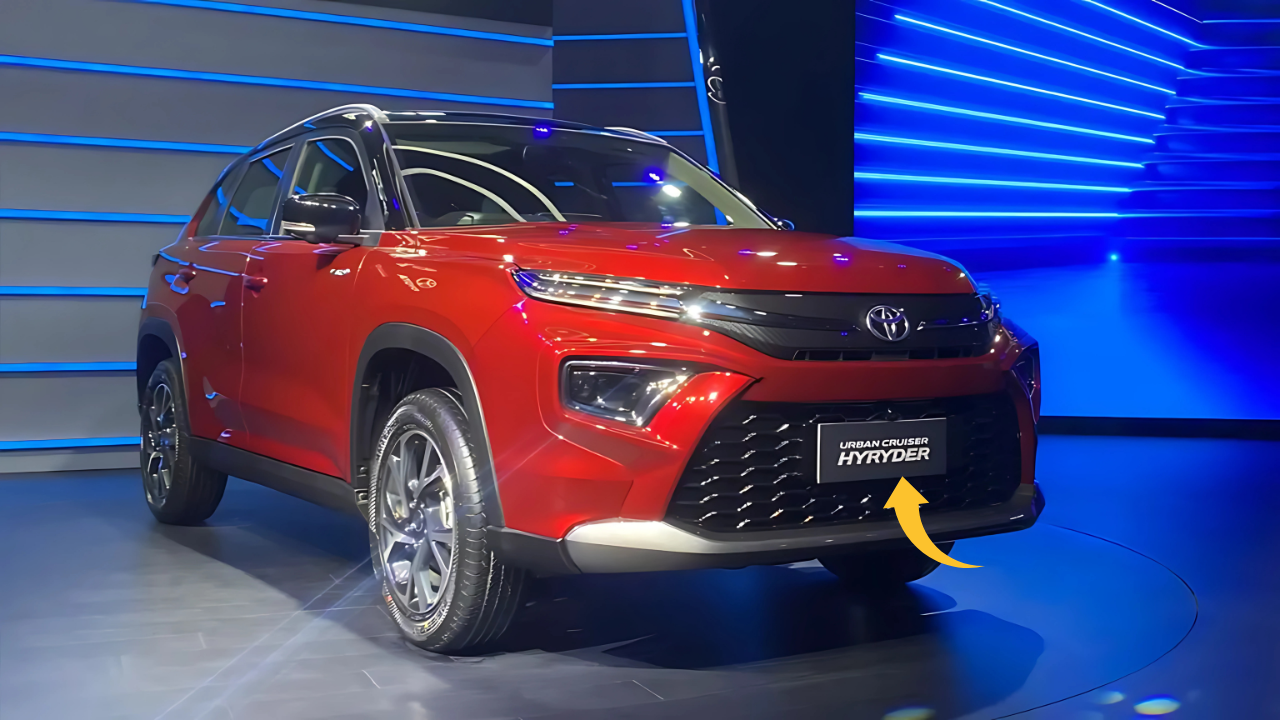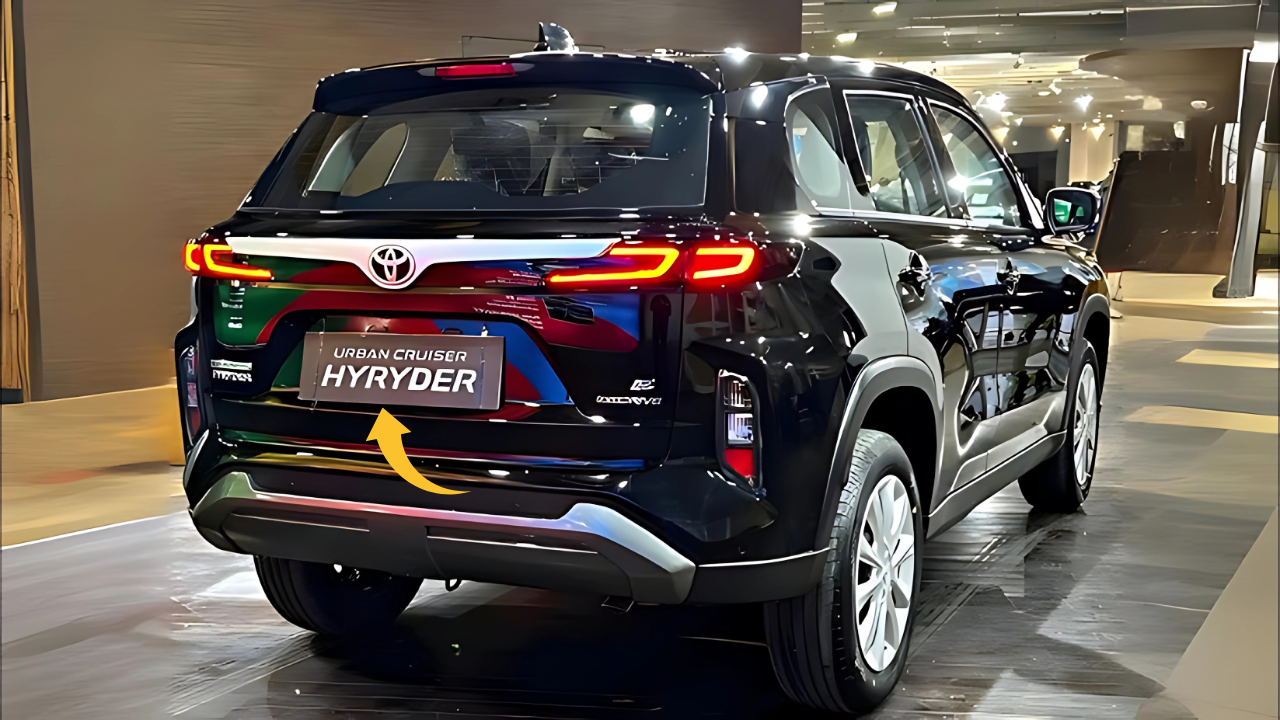Toyota Hyryder: Break Neck News: The Toyota Urban Cruiser Hyryder takes aim at the Maruti Brezza’s perennial leadership of the cutthroat compact SUV segment.
This Toyota and Maruti Suzuki offered product comes with modern hybrid technology in a segment known for convention powertrains and is a good offering for buyers looking for good fuel efficiency without compromising on features and reliability.
Toyota Hyryder Market Entry Strategy
Toyota’s strategy with the Hyryder stands as a calculated dare to traditional conventions. Although the Brezza’s sales performance has been dominated thanks to the traditional petrol engine and brand trust, Toyota is debuting with advanced hybrid tech as its main stall-worth.
This approach specifically targets the increasing consumer interest in fuel-efficient vehicles given the current steep price of petrol.
It’s interesting to have the Hyryder landing as a high-end option at the same time as being relatively accessible. The company expects such potential customers to pause and think about technology that is superior at comparable price points.
This positioning has left Maruti with no choice but to fast-track its electric plans, or lose market share to its joint venture partner for good.
Pricing Architecture
The Hyryder is priced between ₹ 10.5 lakh and ₹ 18.9 lakh (ex-showroom), but the band has been kept overlapping with the Brezza’s. Base versions are slightly cheaper than the Brezza, while top versions get far more advanced tech at a premium but justifiable price.
This pricing formula makes the Hyryder attractive to cost-conscious shoppers, while allowing Mitsubishi to tap on aspirational value for those who wouldn’t mind to shell out more for hybrid technology.
The mild hybrid versions are priced ₹10.5 lakh onwards, and thus directly in the face of Brezza’s mid variants. Offering previously unheard of fuel economy, the strong hybrid system starting at ₹15.1 lakh could recover the premium in the long run through lower operating costs.
This dual-pricing strategy leads to the maximum market coverage while preserving profit.
Technological Edge
The Hyryder’s powerful hybrid tech is one thing that puts it well ahead of the Brezza. That technology delivers fuel savings that conventional powertrains simply can’t match – up to 27.97 km/l.
While in city a Brezza owner will get around 17-18 km/l (my assumption) Hyryder owners are getting 25+ average and that gives huge monthly savings.
The regenerative brake system stores braking power whilst driving which is used to help out during acceleration and in the end makes this car more efficient than it would be if it was operating like a conventional combustion car.
Pure electric motoring at low speeds will help cut noise pollution in traffic-logged urban settings – greener benefits some environmentally-aware shoppers would otherwise opt for alongside the run of the mill Brezza diesels simply because the model’s been around the block and it’s cheap to maintain.
Feature Comparison
Both come equipped with full suites of features, but the Hyryder adds a few top-notch touches. The digital instrument cluster shows off hybrid system related stats in a cool manner, and the nifty heads-up display – missing in the Brezza – means they just have to keep off their eyes off the road.
Interior ambience is also given due attention with dual-zone climate control, and wireless charging that the Brezza either offers only in top spec or doesn’t offer at all.
The panoramic sunroof lends the cabin a premium feel which is no match to the more utilitarian Brezza. These extra features help to justify the small premium in hybrid models, while also keeping non-hybrid model prices competitive.
Design Philosophy
The Hyryder looks much more modern in terms of design language, while the Brezza’s style remains quite traditional. It has a contemporary silhouette, thanks to sharp character lines and a floating roof design that is being increasingly favoured by younger buyers.
The vehicle also has LED lighting signatures on the trim, and an alloy wheel design that oozes a sense of sophistication across the range.
Inside the brown and black dual-tone treatment is more upmarket than the Brezza’s straight forward grey interiors. Soft-touch materials are draped over surfaces of the dash, increasing perceived quality. Those design choices draw in buyers that value modern and contemporary design with their traditional Toyota dependability.
Performance Metrics
The 102 bhp with 142 Nm torque 1.5-liter mild hybrid engine makes power figures similar to the Brezza, only improved fuel economy. The powerful hybrid edition, meanwhile, makes near identical power figures, albeit with added electric assistance for sprightlier, yet airier, pace. In reality, the performance is smooth for the most part, especially in the city.
Transmission choices are clever manual (iMT) and CVT auto, so there’s variety in line with the Brezza too. The CVT unit is designed to make the most of the hybrid system, keeping the engine at its most efficient speed under acceleration. This duo provides a premium driving feel unique from even the most upscale of the utility-crossover competitors.

Market Impact Analysis
Looking at sales figures, the Hyryder’s influence on Brezza’s market share is still substantial, but not formidable. Sharing monthly sales data reveals that the Hyryder is running at an average volume of 10,000-12,000 units as against the 15,000-18,000 units of the Brezza.
This is market expansion rather than pure substitution—many of the people who have bought a Hyryder are hybrids first-timers.
Having two strong rivals is good for us the consumer with competitive pricing and feature additions at play between both units. Maruti has since then slugged it out by loading the Brezza up with features and offering CNG version, evidently showing how the competition brings out the best in the compact SUV space.
Ownership Economics
The low cost of long-time ownership lies in favor of the Hyryder, as it writes down its low-fuel prices. With monthly driving of 1,500 km, hybrid options mean a worth saving of about ₹2,000-3,000 by SUVs of other kinds in a month. “So in five years these savings more than compensate for whatever initial premium there may be.
It never hurts that service costs are competitive, and, well, Toyota has always been known for having reliable vehicles. The hybrid system has very little additional maintenance over that of standard service intervals. The battery warranty is also a comfort to mind for technology junkies worried about long-term hybrid durability.
Future Implications
Maruti’s electric plans are shaped by Hyryder’s success to a great deal. Heavy hybrid penetration in the Indian market paves the way for advanced powertrains technology at the mass market level.
This is the first time the price tag of an electric vehicle in India has been pushed to such low levels, giving into consumers’ wishes which leads to Maruti’s own planned comprehensive electrification plans coming sooner than later and benefiting the consumer with more choice.
Toyota Hyryder Conclusion
The Toyota Urban Cruiser Hyryder can give a tough hunt to the popular leader Maruti Brezza through advanced technology and aggressive pricing.
Although it isn’t the immediate successor to the Brezza, the model’s success reflects shifting consumer tastes for fuel-efficient technology. The segment is better for the competition through continued innovation and better value propositions.
For potential buyers targeting these models, the question increasingly becomes technology adoption versus peace of mind. The former is the future today, the latter offers proven trustworthiness.
This healthy competition drives both these models to evolve, which in turn benefits consumers, increasing choice, quality and innovation in India’s compact SUV segment.
Frequently Asked Questions
Q: What is the Hyryder fuel efficiency and how does it fare against the Brezza under real driving conditions?
A: In city conditions, the Hyryder strong hybrid would easily give you 25-27 km/l whereas Brezza would be around 17-18 km/l, with highways the gap would be bridged further and you will get between 27-28 km/l for Hyryder and 21-22 for Brezza.
Q: So is the price premium of a hybrid worth it?
A: Drivers who clock more than 1,500 km monthly will have their hybrid premium paid back through savings on petrol within 18 to 24 months. Then the continuing savings pay off the initial investment.
Q: How is trustworthy a Toyota hybrid system when compared to Maruti traditional engines?
A: Toyota’s hybrid technology has a track record of reliable use around the world. It is maintenance-free and there is no need for special maintenance or service after installation.Content is protected by battery-warranty, so is reliable and safe.
Q: The Hyryder comes with AWD like some of the Brezzer versions?
A: The Hyryder is FWD only. All-terrain ability is still not the focus – efficiency and technology predominate.
Q: Which is good among Toyota and Maruti for after sales service?
A: Each has far-reaching service networks. Maruti has better penetration in tier-2/3 cities, however, Toyota provides consistently good service at reasonable rates.
Q: Can the hybrid system run in electric-only mode? Q: What is an enhanced electric drive mode feature in a strong hybrid?
A: Enhanced electric drive mode in strong hybrid can offer electric-only drive at low speeds, usually up to 40km/h or so making it advantageous in congested areas Stop-go traffic.
Q: How about luggage space in the two models?
A: The Brezza’s boot space stands at 359 liters at the time of print, as opposed to Hyryder’s 373 liters. Hybrid models have less space due to battery location.
Q: Are replacement components for the hybrid system costly?
A: Most major hybrid parts come with a warranty. Servicing is about the same as for traditionally powered cars, and there is no substantial cost penalty for routine maintenance items
